What happens to your body if you don’t exercise?
You already know that physical activity is great for your health, but is it actually necessary?
After reading this post, you’ll learn why it’s in your best interest to work out regularly.
And if you don’t work out, this post will show you how to start.
Let’s dive right in.
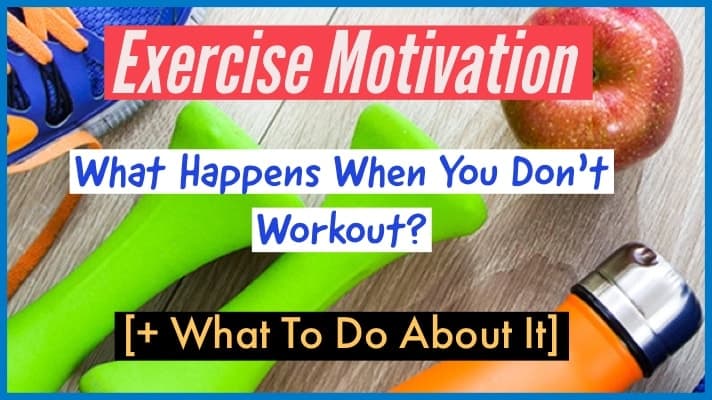
What Happens When You Don’t Workout At All
If you don’t exercise at all, you are part of the majority.
But this isn’t something to write home about.
Not exercising can have several negative effects on your body. Even worse, these changes happen relatively quickly. Short term effects of physical inactivity can be seen as quickly as two weeks.[1]
But it doesn’t end there.
There are several long term effects that can happen, particularly in your hormone profile, your musculoskeletal system, and your cardiovascular system.
Let’s go over each one in just a moment.
I Don’t Exercise But I’m Skinny – Does It Matter?
What if you are already skinny, and naturally have a high metabolism.
Do you really have to exercise?
Yes. You still should exercise even if you are skinny. While you may not experience as many side effects as someone who is obese, you still have a lot to gain from working out.
You cannot escape your biology. Your body expects you to be a physically active person.
We did not evolve to have uber driving us everywhere and have amazon prime delivering everything we need to our doorstep.
Physical inactivity can lead to several short term and long term risks.
Let’s start with the…
Short Term Effects Of Not Exercising
Negative Adaptation: AKA Deconditioning
The first and most obvious effect of physical inactivity is deconditioning.
Your body is a machine at adapting to what you do. The more you run, the better you get at running. The more you study math, the better you get at math.
But it goes both ways.
The same is true for unlearning things. The less you speak a second language, the more likely you will forget it.
The less physical activity you do, the more your body will adapt to being sedentary. Sadly, this is what your body prefers.
It would much rather you lounge around and eat than exercising.
1 This is easier
2 You spend less energy (calories)
Your heart doesn’t need to work as hard to pump blood to active muscles. Your lungs don’t need to work as hard to bring oxygen to support exercise
This ultimately leads to you becoming deconditioned and unable to tolerate much exercise at all.
Shortness Of breath with minimal exertion
Along those same lines, you will also experience shortness of breath with minimal exertion.
This means every time you go up a flight of stairs, you will be gasping for air. Anytime you carry groceries in from the market, you will get winded. Each time you play with your kids you won’t be able to keep up for very long.
Your cardiorespiratory system simply won’t be trained to handle that much work.
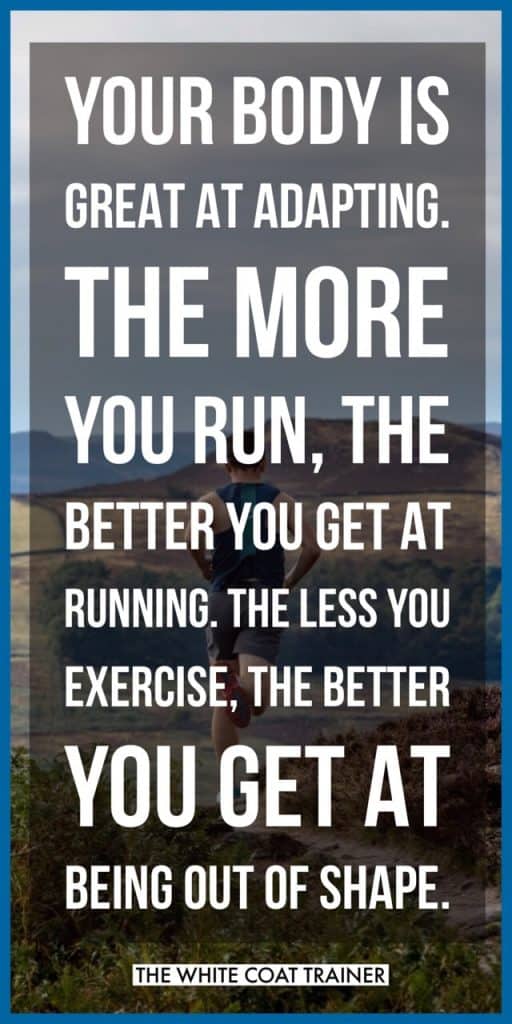
Lethargy
Have you ever sat around doing nothing all day? How did you feel by the end of it?
Energized, refreshed, and ready to exercise?
No?
I didn’t think so.
Surprisingly, the more you exercise, the more energetic you become. Every single cell in your body has something called the mitochondria.
The mitochondria are known as the “powerhouse” of the cell as it produces all of the cell’s energy.
Whenever you exercise regularly, your mitochondria have to constantly produce energy to keep you going. This energy tends to linger much after you finish exercising too.
Exercise also releases hormones known as endorphins. (We will talk more about these a little later.) These hormones also cause a burst of energy helping to keep you going.
This is why you may hear the recommendation to not exercise a couple of hours before you sleep. [2]
So those are the short term effects.
They then begin to compound over time.
What Are The Long Term Risks of Not Exercising?
Physical inactivity can also have several long term effects on your body.
In this next section, you’ll learn about the effects it can have on your brain, your hormones, and your musculoskeletal system.
You May Be Negatively Impacting Your Sleep and Restoration
Almost everything your body does is controlled by one or more hormones. A hormone is a chemical that your body releases that can act on distant organs.
One of those hormones is melatonin. Melatonin is known as the sleep hormone. It tends to increase in the dark and promote a state of restfulness.
Exercise can also play a role in helping the natural secretion of this hormone and establishing a healthy circadian rhythm. [3]
Exercise is also known to improve sleep quality and sleep duration. [4]
Some data have suggested that the opposite is true as well. Physical inactivity may be linked to a decrease in sleep length and sleep quality. [5]
It is well known that sleep is the ultimate anabolic state. A decrease in sleep quality and duration is linked to several disease processes.
Why not decrease these effects with just a little exercise?
Both aerobic and resistance training exercise have been shown to positively effect your long term sleep.
Physical Inactivity Will Cause This To Slow Down
Another important thing to consider is your metabolism. Your metabolism is a collection of how your body processes and uses energy.
If you have a “fast metabolism,” your body burns a lot of energy and you are likely to be thin. The opposite is true if you have a “slow metabolism.”
While this is an oversimplification of a very complicated system, it is well known that metabolism slows down with aging. [6]
This means that you cannot eat the same amount of food as before and expect to stay at the same levels of body fat.
This also means that you cannot expect to exercise less and stay at the same levels of body fat.
In general, you will gain body fat as you get older.
Why does this happen?
Several reasons as outline by this article on healthline.
- Metabolic processes in your body slow down
- You lose muscle mass
- You become less active
You can impact # 2 and #3.
You can preserve muscle mass by remaining active.
Exercise is one of the best methods we know of to help maintain a healthy metabolism. [7] While the increase is modest, it cannot be ignored.
The decline in your metabolism can start to happen as early as your 30s.
Some experts say that your metabolism drops by about 1-2% every decade. This can equate to you having to consume 150 fewer calories per day.
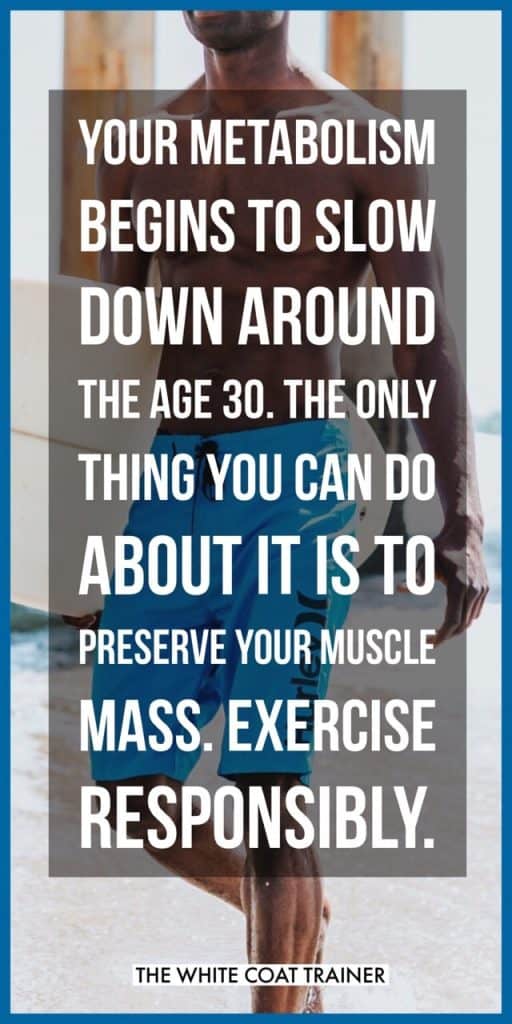
You Miss Out On Positive Effects On Your Mood & Stress
Exercise has also been linked to a decrease in stress and improvements in mood. [8]
Exercise releases a class of chemicals known as endorphins. You may have heard of them as the feel-good hormones.
These hormones activate opioid receptors in your body to elevate your mood and decrease pain.
These are the same receptors that get activated when you take a narcotic medication.
Isn’t that interesting?
Even still, studies have even confirmed that exercise can be just as effective as antidepressants in treating major depression. [9]
Why wouldn’t you take advantage of this natural method of stress and mood relief?
You Increase Risk of Injury Doing These Everyday Things
Physical activity is also important to help you maintain mobility in your joints and muscles.
As you get older and busier, you naturally participate in less physical activities. Moving less results in a diminished ability to perform such tasks.
The old adage, “use it or lose it” applies here.
You have to use your joints in a way that complements their full range of motion. Otherwise, your joints eventually become weak, stiff, and immobile.
Without adequate mobility, your body will compensate to perform basic everyday movements that require a full range of motion.
You might think that this is inconsequential.
Why should you care about a range of motion if you don’t lift weights or plan on participating in athletic activities anymore?
The more appropriate question is…
How many times have you seen a non-athletic person injure themselves in the real world?
Have you seen someone pick up a grocery bag and their back gave out?
What about someone climbing a flight of stairs and now their knee won’t stop hurting?
Or someone putting groceries away on shelves and hearing a pop in their shoulder?
You would be shocked to know that the vast majority of patients who visit orthopedic surgeons are not athletes. They are average people who injure themselves doing normal everyday activities.
If you don’t exercise, you become stiff and begin to move improperly. After some time, just like the camel – one more straw will eventually break your back.
Your Muscles Become Flaccid: The Effects of Not Exercising on Muscle
Last but not least, if you don’t use your muscles, you lose them as well.
This is known as muscle atrophy.
Muscle is metabolically active tissue. Your body has to burn extra calories to maintain them.
If it had a choice it would much rather get rid of muscle tissue, especially if they aren’t being used.
And that is precisely what happens.
Muscle loss contributes to the slowing of your metabolism, a decrease in strength, and a decrease in energy.
But wait it gets worse…
Are There Other Major Health Effects Of Not Exercising?
Everything we have discussed so far is related to things you might not care about.
But maybe this will catch your attention.
When you don’t exercise, you increase your risk of developing numerous diseases.
Diseases that are thought to be lifestyle-related- aka possibly preventable.
These include hypertension, diabetes, and heart disease.
- High Blood Pressure: One of the biggest risk factors in the development of strokes
- Diabetes: One of the leading killers in the United States – aka the silent killer.
- Heart Disease: The number one cause of death in the United States
It is a stretch to say that exercise alone will prevent these diseases from happening, but data shows that it can certainly help. [10]
Couple this with a balanced diet full of fruits, vegetables, water, and other key nutrients to increase the effect further.
Oh, yea…
Not exercising has been linked to premature death as well. [11]
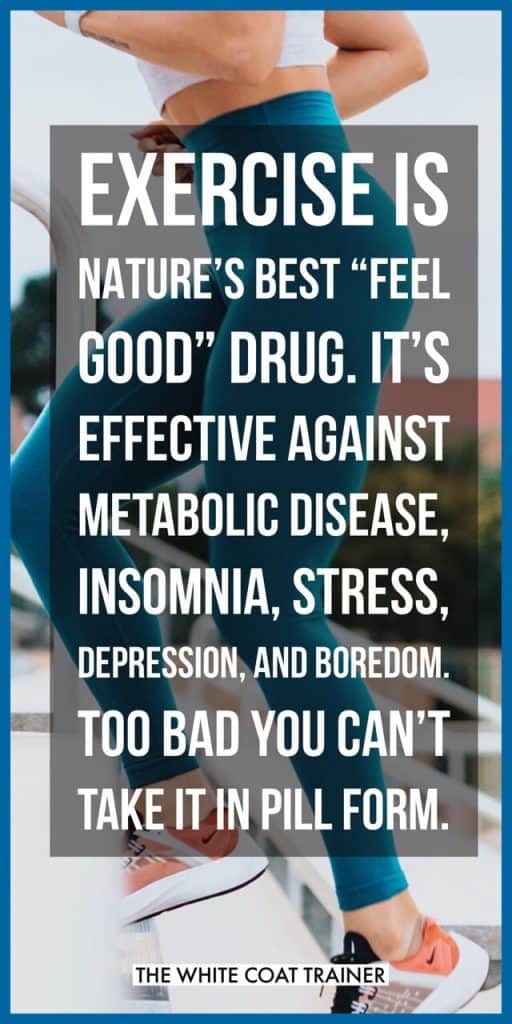
How To Start Exercising If You Don’t Exercise At All
Alright, are you convinced yet?
Let’s go over the easiest way to start exercising if you don’t work out at the moment.
There are two forms of exercise that you should do.
- Aerobic Exercise
- Resistance Training
Let’s talk about how to incorporate each one.
How To Get Started With Aerobic Exercise
Aerobic exercise refers to any physical activity that is of moderate to long duration and requires you to breathe.
This type of exercise is great to help support a strong cardiorespiratory system. It also improves total body circulation
The most common example you are probably thinking of is running on a treadmill.
But there’s good news.
You don’t have to run on a treadmill.
If you’re just starting out, all you have to do is go on more walks.
Heck, even if you’re not starting out, this is a great way to get aerobics in. It is my personal go-to exercise.
Walking is the quintessential form of exercise. It is available to just about everyone.
You can do it anytime, anywhere, and best of all it is free.
Walk outside. Walk inside. Walk on a treadmill. Do it in the morning. Do it immediately after work.
Start with just a 10-minute walk every day. Don’t skip a day. 10 minutes is an easy investment that you can make.
You could even listen to a podcast or an audiobook while you are doing it.
How To Get Started With Resistance Training
Once you feel that you have incorporated daily walking as part of your routine, it is time to add resistance training.
Resistance training is the only way to build muscle.
Muscle is necessary to keep your body strong, maintain a high metabolism, and decrease your risk of common injuries.
There are two types of resistance exercises you can perform.
- Calisthenics: AKA Bodyweight training
- Weights: Lifting dumbbells, barbells, kettlebells, etc
Both are excellent and you cannot go wrong with either approach.
If you need help deciding which method to use, check out our post on calisthenics vs weights.
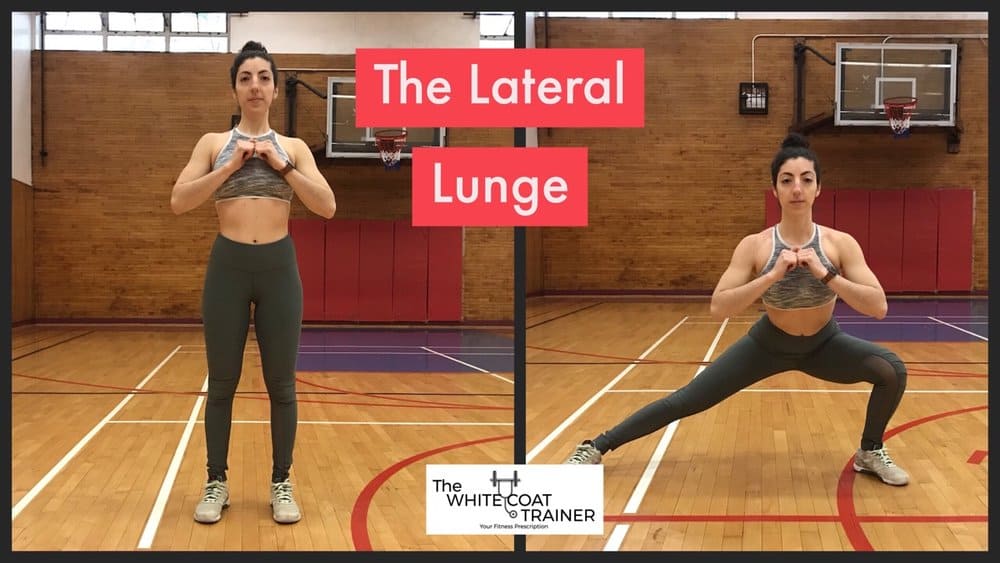
Once you have made your decision, the next step is to learn the 6 basic fundamental human movement patterns.
At least 80% of the exercises you perform should be a variation to one of these 6 exercises.
You can learn more on our comprehensive post on getting started with calisthenics or on creating a fitness plan for the gym.
We also have ready-made comprehensive workout programs that you can use right away.
Wrap Up
Exercise is a crucial part of our existence. Without it, our body begins to break down and physically and metabolically.
If you don’t exercise now, just start by taking a 10-minute walk on a daily basis. It will do you some good.
What do you think?
Do you exercise at all? Are you going to start?
Comment below and let us know.
Next, You Should Read:
- 3 Basic Principles of Exercise You Need To Know Before Working Out
- How To Get Started With Calisthenics
- How To Get Started With Weights

Alex Robles, MD, CPT / Brittany Robles, MD, MPH, CPT
Alex & Brittany Robles are physicians, NASM Certified Personal Trainers, and founders of The White Coat Trainer: a resource dedicated to improving the health and fitness of busy professionals using time-efficient strategies. Their advice has been featured in My Fitness Pal, Prevention, Livestrong, Reader’s Digest, Bustle, The Active Times, and more. Learn more about them here.
References:
1) Vigelsø, Andreas, et al. “Six weeks’ aerobic retraining after two weeks’ immobilization restores leg lean mass and aerobic capacity but does not fully rehabilitate leg strength in young and older men.” Journal of rehabilitation medicine 47.6 (2015): 552-560.
2) Yamanaka, Yujiro, et al. “Morning and evening physical exercise differentially regulate the autonomic nervous system during nocturnal sleep in humans.” American Journal of Physiology-Regulatory, Integrative and Comparative Physiology 309.9 (2015): R1112-R1121.
3) Gabriel, Brendan M., and Juleen R. Zierath. “Circadian rhythms and exercise—re-setting the clock in metabolic disease.” Nature Reviews Endocrinology (2019): 1.
4) Dolezal, Brett A., et al. “Interrelationship between sleep and exercise: a systematic review.” Advances in preventive medicine 2017 (2017)
5) Kline, Christopher E. “The bidirectional relationship between exercise and sleep: implications for exercise adherence and sleep improvement.” American journal of lifestyle medicine 8.6 (2014): 375-379.
6) Shimokata, H., and F. Kuzuya. “Aging, basal metabolic rate, and nutrition.” Nihon Ronen Igakkai zasshi. Japanese journal of geriatrics 30.7 (1993): 572-576.
7) Pratley, R., et al. “Strength training increases resting metabolic rate and norepinephrine levels in healthy 50-to 65-yr-old men.” Journal of Applied Physiology 76.1 (1994): 133-137.
8) Hearing, C. M., et al. “Physical exercise for treatment of mood disorders: a critical review.” Current behavioral neuroscience reports 3.4 (2016): 350-359.APA
9) Blumenthal, James A., Patrick J. Smith, and Benson M. Hoffman. “Is exercise a viable treatment for depression?.” ACSM’s health & fitness journal 16.4 (2012): 14.
10) Fishman, Ezra I., et al. “Association between objectively measured physical activity and mortality in NHANES.” Medicine and science in sports and exercise 48.7 (2016): 1303.
11) https://www.cdc.gov/pcd/issues/2018/17_0354.htm

I believe the statistic is roughly 80% of Americans don’t get 2 hours of exercise per week. Or something pretty scary like that. I’m actually amazed that people do as well as they do with such little activity.
Totally agree. It’s quite shocking.